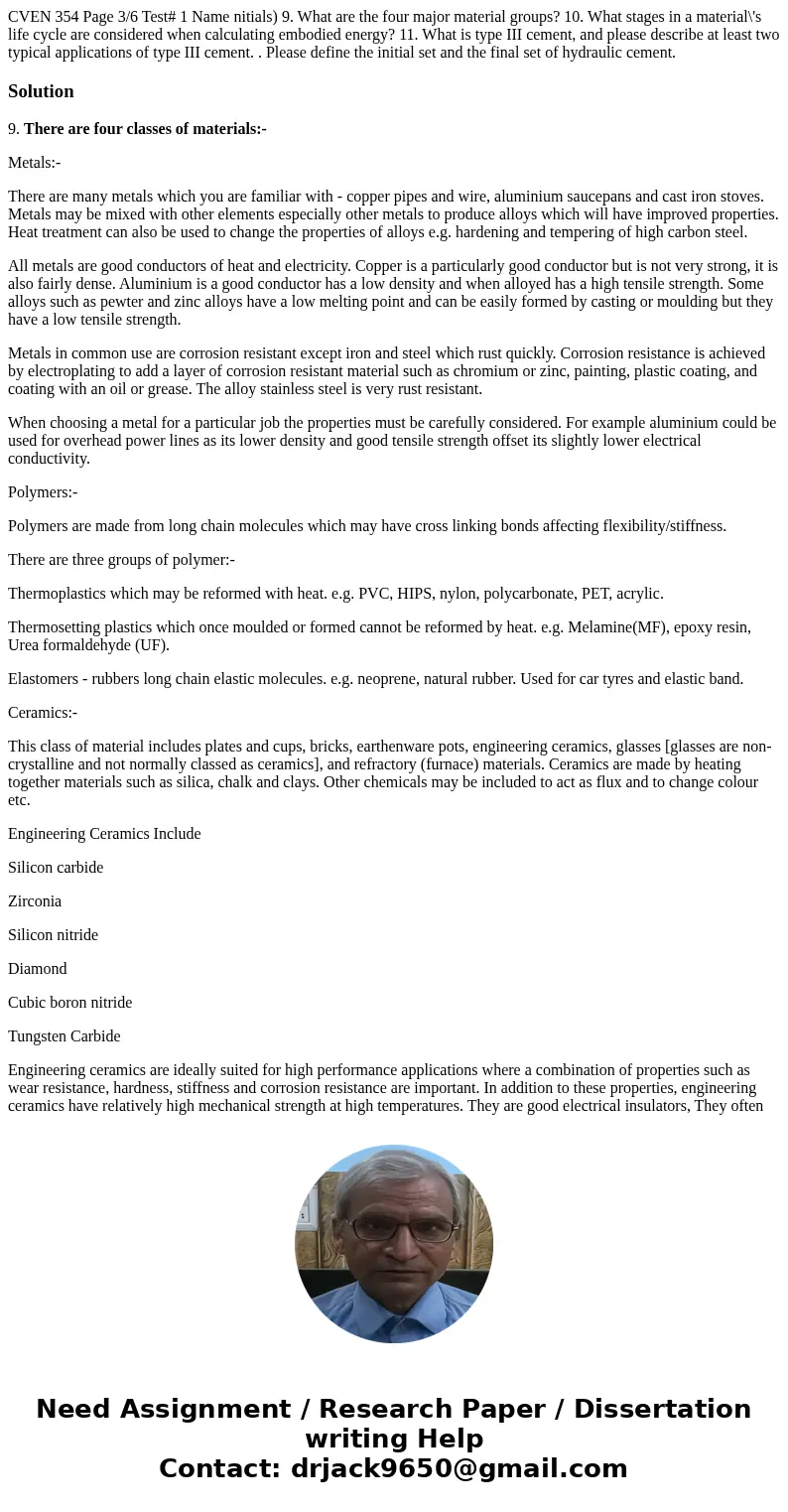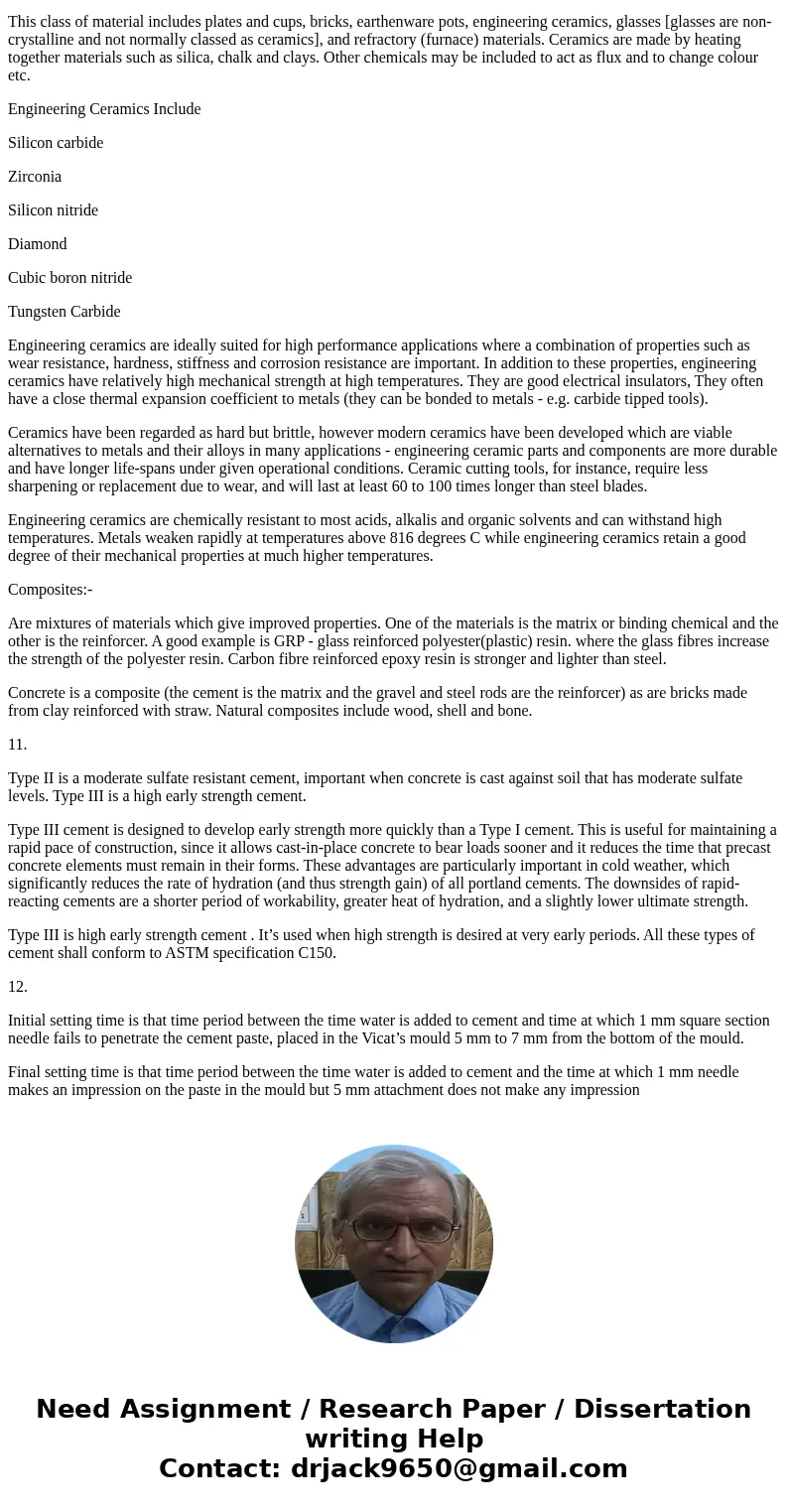CVEN 354 Page 36 Test 1 Name nitials 9 What are the four maj
Solution
9. There are four classes of materials:-
Metals:-
There are many metals which you are familiar with - copper pipes and wire, aluminium saucepans and cast iron stoves. Metals may be mixed with other elements especially other metals to produce alloys which will have improved properties. Heat treatment can also be used to change the properties of alloys e.g. hardening and tempering of high carbon steel.
All metals are good conductors of heat and electricity. Copper is a particularly good conductor but is not very strong, it is also fairly dense. Aluminium is a good conductor has a low density and when alloyed has a high tensile strength. Some alloys such as pewter and zinc alloys have a low melting point and can be easily formed by casting or moulding but they have a low tensile strength.
Metals in common use are corrosion resistant except iron and steel which rust quickly. Corrosion resistance is achieved by electroplating to add a layer of corrosion resistant material such as chromium or zinc, painting, plastic coating, and coating with an oil or grease. The alloy stainless steel is very rust resistant.
When choosing a metal for a particular job the properties must be carefully considered. For example aluminium could be used for overhead power lines as its lower density and good tensile strength offset its slightly lower electrical conductivity.
Polymers:-
Polymers are made from long chain molecules which may have cross linking bonds affecting flexibility/stiffness.
There are three groups of polymer:-
Thermoplastics which may be reformed with heat. e.g. PVC, HIPS, nylon, polycarbonate, PET, acrylic.
Thermosetting plastics which once moulded or formed cannot be reformed by heat. e.g. Melamine(MF), epoxy resin, Urea formaldehyde (UF).
Elastomers - rubbers long chain elastic molecules. e.g. neoprene, natural rubber. Used for car tyres and elastic band.
Ceramics:-
This class of material includes plates and cups, bricks, earthenware pots, engineering ceramics, glasses [glasses are non-crystalline and not normally classed as ceramics], and refractory (furnace) materials. Ceramics are made by heating together materials such as silica, chalk and clays. Other chemicals may be included to act as flux and to change colour etc.
Engineering Ceramics Include
Silicon carbide
Zirconia
Silicon nitride
Diamond
Cubic boron nitride
Tungsten Carbide
Engineering ceramics are ideally suited for high performance applications where a combination of properties such as wear resistance, hardness, stiffness and corrosion resistance are important. In addition to these properties, engineering ceramics have relatively high mechanical strength at high temperatures. They are good electrical insulators, They often have a close thermal expansion coefficient to metals (they can be bonded to metals - e.g. carbide tipped tools).
Ceramics have been regarded as hard but brittle, however modern ceramics have been developed which are viable alternatives to metals and their alloys in many applications - engineering ceramic parts and components are more durable and have longer life-spans under given operational conditions. Ceramic cutting tools, for instance, require less sharpening or replacement due to wear, and will last at least 60 to 100 times longer than steel blades.
Engineering ceramics are chemically resistant to most acids, alkalis and organic solvents and can withstand high temperatures. Metals weaken rapidly at temperatures above 816 degrees C while engineering ceramics retain a good degree of their mechanical properties at much higher temperatures.
Composites:-
Are mixtures of materials which give improved properties. One of the materials is the matrix or binding chemical and the other is the reinforcer. A good example is GRP - glass reinforced polyester(plastic) resin. where the glass fibres increase the strength of the polyester resin. Carbon fibre reinforced epoxy resin is stronger and lighter than steel.
Concrete is a composite (the cement is the matrix and the gravel and steel rods are the reinforcer) as are bricks made from clay reinforced with straw. Natural composites include wood, shell and bone.
11.
Type II is a moderate sulfate resistant cement, important when concrete is cast against soil that has moderate sulfate levels. Type III is a high early strength cement.
Type III cement is designed to develop early strength more quickly than a Type I cement. This is useful for maintaining a rapid pace of construction, since it allows cast-in-place concrete to bear loads sooner and it reduces the time that precast concrete elements must remain in their forms. These advantages are particularly important in cold weather, which significantly reduces the rate of hydration (and thus strength gain) of all portland cements. The downsides of rapid-reacting cements are a shorter period of workability, greater heat of hydration, and a slightly lower ultimate strength.
Type III is high early strength cement . It’s used when high strength is desired at very early periods. All these types of cement shall conform to ASTM specification C150.
12.
Initial setting time is that time period between the time water is added to cement and time at which 1 mm square section needle fails to penetrate the cement paste, placed in the Vicat’s mould 5 mm to 7 mm from the bottom of the mould.
Final setting time is that time period between the time water is added to cement and the time at which 1 mm needle makes an impression on the paste in the mould but 5 mm attachment does not make any impression


 Homework Sourse
Homework Sourse